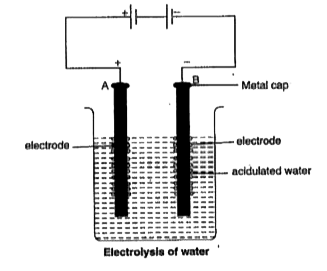Acidified water is electrolysed by using carbon electrodes. What is produced at
negative carbon electrode
To determine what is produced at the negative carbon electrode (cathode) during the electrolysis of acidified water, we can follow these steps:
1. Identify the Electrolysis Setup:
- We are electrolyzing acidified water using carbon electrodes. Acidified water means water that has been mixed with an acid (like sulfuric acid) to increase the conductivity.
2. Understand the Role of Electrodes:
- In electrolysis, the negative electrode is called the cathode, and the positive electrode is called the anode. At the cathode, a reduction reaction occurs, which involves the gain of electrons.
3. Write the Reaction at the Cathode:
- The reaction that occurs at the cathode during the electrolysis of acidified water can be represented as:
4H2O+4e−→2H2+4OH−
- This equation shows that water molecules (H2O) gain electrons (e^-) to produce hydrogen gas (H2) and hydroxide ions (OH^-).
4. Identify the Product:
- From the reaction, we can see that hydrogen gas (H2) is produced at the cathode.
5. Conclusion:
- Therefore, the product produced at the negative carbon electrode during the electrolysis of acidified water is hydrogen gas.
Final Answer:
At the negative carbon electrode (cathode), hydrogen gas (H2) is produced.
---
- We are electrolyzing acidified water using carbon electrodes. Acidified water means water that has been mixed with an acid (like sulfuric acid) to increase the conductivity.
- In electrolysis, the negative electrode is called the cathode, and the positive electrode is called the anode. At the cathode, a reduction reaction occurs, which involves the gain of electrons.
- The reaction that occurs at the cathode during the electrolysis of acidified water can be represented as:
4H2O+4e−→2H2+4OH−
- This equation shows that water molecules (H2O) gain electrons (e^-) to produce hydrogen gas (H2) and hydroxide ions (OH^-).
- From the reaction, we can see that hydrogen gas (H2) is produced at the cathode.
- Therefore, the product produced at the negative carbon electrode during the electrolysis of acidified water is hydrogen gas.
At the negative carbon electrode (cathode), hydrogen gas (H2) is produced.
Similar Questions
Knowledge Check
Brine is electrolysed by using inert electrodes. The reaction at anode is_______
ACl−(aq.)→12Cl2(g)+e−,E⊙cell=1.36VB2H2O(l)→O2(g)4H++4e−,E⊙cell=1.23VCNa+(aq.)+e−→Na(s),E⊙cell=2.71VDH+(aq.)+e−→12H2(g),E⊙cell=0.00VWhen CuSO4 is electrolysed, using Pt electrodes
Acopper is deposited at cathode, sulpher is liberates at anodeBcopper is deposited at cathode, oxygen gas is liberated at andoeCoxygen gas is liberated at cathode, copper is deposited at anodeDsulphur is deposited at cathode, oxygen gas is liberated at anodeBrine is electrolysed by using inert electrodes. The reaction at anode is _____.
ACl−(aq)→12Cl2(g)+e−, E∘Cell=1.36VB2H2O(l)→O2(g)+4H++4e−, E∘Cell=1.23VCNa+(aq)+e−→Na(s), E∘Cell=2.71VDH+(aq)+e−→12H2(g), E∘Cell=0.00V
Brine is electrolysed by using inert electrodes. The reaction at anode is_______
View SolutionBrine is electrolysed by using inert electrodes. The reaction at anode is…………….
View SolutionBrine is electrolysed by using inert electrodes. The reaction at anode is_______
View SolutionWhen an aqueous solution of sodium chloride is electrolysed using platinum electrodes, the ion discharged at the electrodes are
View SolutionWhen an aqueous solution of sodium chloride is electrolysed using platimun electrodes, the ion discharged at the electrodes are
View Solution

